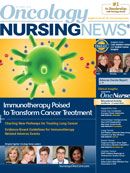Subgroup Analyses Show Depth of Everolimus Benefit in BOLERO-2
New analyses of the BOLERO-2 trial found that everolimus and exemestane produced significantly longer progression- free survival (PFS) than placebo and exemestane in several previously unstudied patient subgroups.
Hope Rugo, MD
New analyses of the BOLERO-2 trial found that everolimus and exemestane produced significantly longer progression- free survival (PFS) than placebo and exemestane in several previously unstudied patient subgroups. The data were presented at the 2013 Breast Cancer Symposium (Abstracts 142, 152).
The first analysis found that everolimus plus exemestane prolonged PFS in patients with hormone receptor—positive advanced breast cancer who received treatment as first-line therapy for advanced breast cancer.
The first analysis found that everolimus plus exemestane prolonged PFS in patients with hormone receptor—positive advanced breast cancer who received treatment as first-line therapy for advanced breast cancer.
The everolimus group had significantly longer PFS compared with the placebo group (11.50 vs 4.07 months, respectively; hazard ratio [HR] = 0.39; 95% CI, 0.25-0.62). Median PFS remained longer with everolimus versus placebo, regardless of whether chemotherapy was included with the prior adjuvant hormonal therapy.
Pending results from the recently launched BOLERO-4 trial, which will directly evaluate the efficacy of everolimus as a first-line therapy in patients with hormone receptor—positive advanced breast cancer, these results support the combination of everolimus plus exemestane in patients whose cancer recurs after adjuvant therapy or never responds to that therapy, said lead author Hope Rugo, MD, professor of Medicine and director of Breast Oncology and Clinical Trials Education at the University of California, San Francisco.
“Many people have assumed that everolimus would do nothing for patients who did not initially respond to hormone therapy and then grow resistant to it, that hormone therapy simply wouldn’t work for that patient group,” Rugo said. “But these results strongly suggest that everolimus can help hormones work in patients who never respond to hormones as a monotherapy."
Rugo was also the lead author of the second trial, which analyzed genetic materials from a representative sample of 227 BOLERO-2 participants (157 in the everolimus arm and 70 in the placebo arm) to test how different mutations responded during the initial trial. Exon sequence and gene copy number variations were analyzed in 182 cancer-related genes by next-generation sequencing (NGS). Correlations with PFS were evaluated using univariate and multivariate Cox proportional hazard models.
The treatment benefit of everolimus over placebo was maintained in the subgroups defined by each of the nine genes with a mutation rate >10% (eg, PIK3CA, FGFR1, CCND1) or when less frequently mutated genes (eg, PTEN, AKT1) were included in their respective pathways. Patients with 0 or 1 genetic alterations in PI3K or FGFR pathways or CCND1 had a greater treatment effect from everolimus (HR = 0.27; 95% CI, 0.18- 0.41, adjusted by covariates, in 76% of the NGS population), indicating the value of these pathways for predicting sensitivity to everolimus in this setting.
“Almost half of the tumors had a mutation in PI3K and the others had less-common mutations that included cell cycle pathway markers, as well as fibroblast growth factor receptor and others,” Rugo said. “All patients, no matter what their individual mutations, benefited from the addition of everolimus, which was quite curious. It didn’t matter whether the patients had an activation in the PI3K pathway or not.”
But the news was not all good. “Patients whose tumors had mutations in multiple pathways, which was a small subset, seemed to have the worst overall outcome,” Rugo said, “and they did not benefit from the addition of everolimus.”
On the whole, Rugo thinks that the BOLERO-2 results and all of the subsequent analyses indicate that everolimus is a major step forward in the treatment of hormone receptor—positive breast cancer.
“We’ll have a better idea of just how major the advance is when we see the overall survival data from BOLERO-2, which should be out next year, but every indication we have so far is excellent,” Rugo said.
Nurse Perspective
Janice Famorca Tran, RN, MS, AOCNP, CBCN, ANP-C
Texas Oncology
Houston, TX
Breast cancer treatment has significantly progressed with the discovery of the different pathways that promote breast cancer. The subgroup analysis of the BOLERO-2 trial revealed that hormone-positive, HER2-negative women who had fewer mutated genes in PI3K, FGFR, or CCND1 received more benefit from everolimus than those who had multiple mutations. Almost half of the tumors had a mutation in the PI3K pathway.
Mutations in the PI3K pathway comprise the most common genetic alterations in breast cancer. Furthermore, this subgroup analysis revealed that individuals who had mutations in several pathways did worse, lending insight into the value of additional targeted therapies depending on an individual’s mutation type.
This study illustrates the importance of personalized medicine. The evolution of personalized medicine has allowed clinicians to treat patients on an individualized level, specifically tailored to one’s genetics. The focus of targeting specific genetic pathways driving breast cancer has revolutionized the treatment of breast cancer.
The results from this trial warrant continued research efforts with a concentration on the genomics of breast cancer in the management and treatment of this disease.

Nurse Practitioners Weigh in on Data From the San Antonio Breast Cancer Symposium
January 16th 2023Loyda Braithwaite, MSN, RN, AGPCNP-BC, AOCNP; and Jamie Carroll, APRN, CNP, MSN, highlight presentations from the 2022 San Antonio Breast Cancer Symposium that will influence oncology nursing practice.
FDA Grants Accelerated Approval to Fam-Trastuzumab Deruxtecan-Nxki in HER2+ Solid Tumors
April 5th 2024The FDA granted accelerated approval to fam-trastuzumab deruxtecan-nxki (Enhertu) for patients with unresectable or metastatic HER2-positive solid tumors who have received prior systemic treatment.



